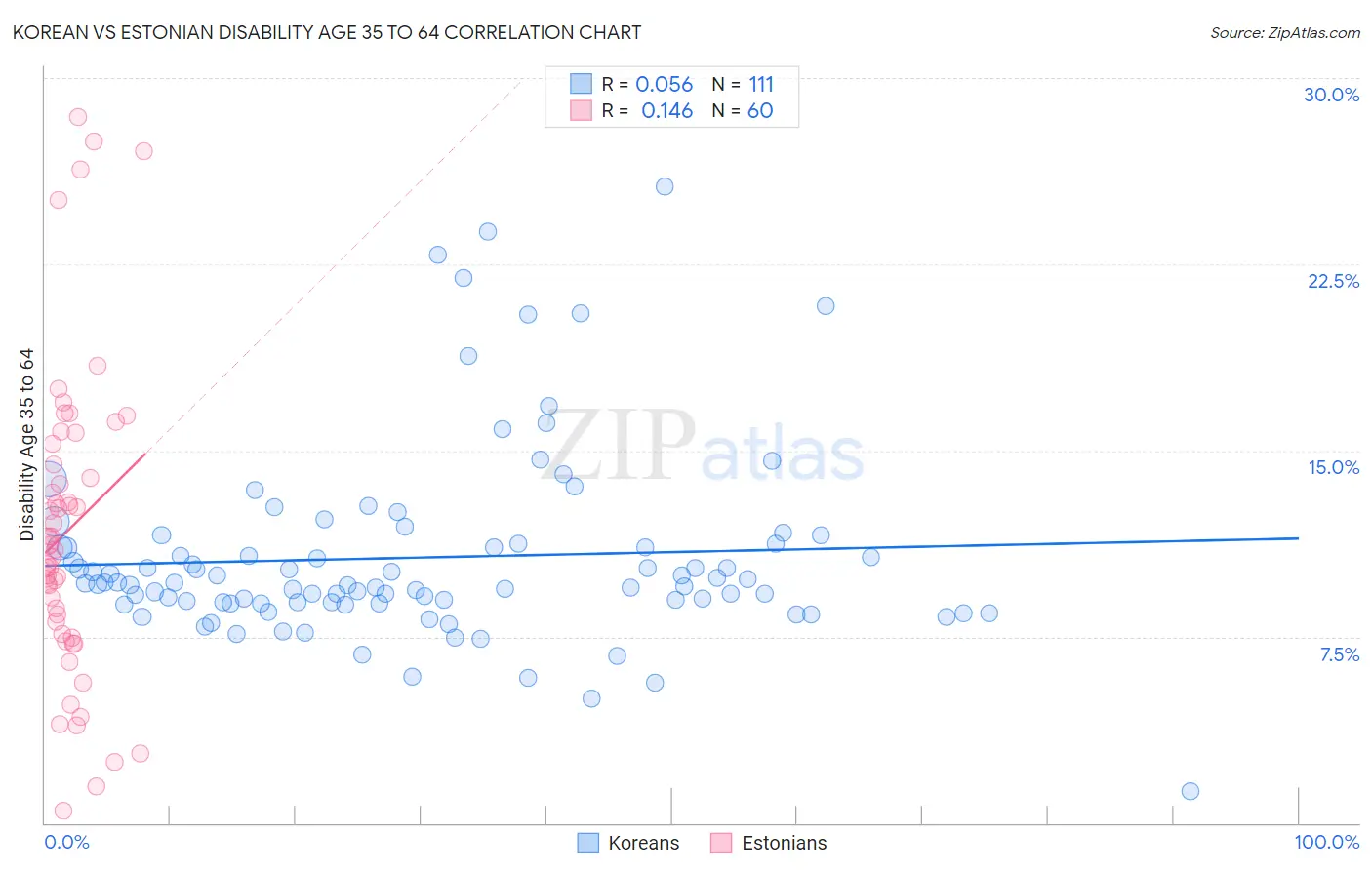Korean vs Estonian Disability Age 35 to 64
COMPARE
Korean
Estonian
Disability Age 35 to 64
Disability Age 35 to 64 Comparison
Koreans
Estonians
10.5%
DISABILITY AGE 35 TO 64
97.1/ 100
METRIC RATING
110th/ 347
METRIC RANK
10.6%
DISABILITY AGE 35 TO 64
94.5/ 100
METRIC RATING
124th/ 347
METRIC RANK
Korean vs Estonian Disability Age 35 to 64 Correlation Chart
The statistical analysis conducted on geographies consisting of 510,268,552 people shows a slight positive correlation between the proportion of Koreans and percentage of population with a disability between the ages 34 and 64 in the United States with a correlation coefficient (R) of 0.056 and weighted average of 10.5%. Similarly, the statistical analysis conducted on geographies consisting of 123,493,933 people shows a poor positive correlation between the proportion of Estonians and percentage of population with a disability between the ages 34 and 64 in the United States with a correlation coefficient (R) of 0.146 and weighted average of 10.6%, a difference of 1.5%.

Disability Age 35 to 64 Correlation Summary
| Measurement | Korean | Estonian |
| Minimum | 1.3% | 0.48% |
| Maximum | 25.7% | 28.4% |
| Range | 24.4% | 28.0% |
| Mean | 10.7% | 11.8% |
| Median | 9.6% | 11.1% |
| Interquartile 25% (IQ1) | 8.9% | 7.9% |
| Interquartile 75% (IQ3) | 11.2% | 14.9% |
| Interquartile Range (IQR) | 2.4% | 7.0% |
| Standard Deviation (Sample) | 3.9% | 6.2% |
| Standard Deviation (Population) | 3.8% | 6.1% |
Demographics Similar to Koreans and Estonians by Disability Age 35 to 64
In terms of disability age 35 to 64, the demographic groups most similar to Koreans are Immigrants from Ethiopia (10.5%, a difference of 0.060%), Ethiopian (10.5%, a difference of 0.20%), Brazilian (10.5%, a difference of 0.20%), Zimbabwean (10.4%, a difference of 0.22%), and Assyrian/Chaldean/Syriac (10.5%, a difference of 0.24%). Similarly, the demographic groups most similar to Estonians are Albanian (10.6%, a difference of 0.10%), Maltese (10.6%, a difference of 0.12%), Immigrants from Afghanistan (10.6%, a difference of 0.16%), Immigrants from Zimbabwe (10.6%, a difference of 0.20%), and Immigrants from Norway (10.6%, a difference of 0.21%).
| Demographics | Rating | Rank | Disability Age 35 to 64 |
| Zimbabweans | 97.4 /100 | #107 | Exceptional 10.4% |
| Ethiopians | 97.4 /100 | #108 | Exceptional 10.5% |
| Immigrants | Ethiopia | 97.2 /100 | #109 | Exceptional 10.5% |
| Koreans | 97.1 /100 | #110 | Exceptional 10.5% |
| Brazilians | 96.9 /100 | #111 | Exceptional 10.5% |
| Assyrians/Chaldeans/Syriacs | 96.8 /100 | #112 | Exceptional 10.5% |
| Tongans | 96.6 /100 | #113 | Exceptional 10.5% |
| Immigrants | Morocco | 96.6 /100 | #114 | Exceptional 10.5% |
| Immigrants | Netherlands | 96.3 /100 | #115 | Exceptional 10.5% |
| Immigrants | Nepal | 95.9 /100 | #116 | Exceptional 10.6% |
| Immigrants | South Eastern Asia | 95.7 /100 | #117 | Exceptional 10.6% |
| Immigrants | Moldova | 95.5 /100 | #118 | Exceptional 10.6% |
| Luxembourgers | 95.5 /100 | #119 | Exceptional 10.6% |
| Vietnamese | 95.4 /100 | #120 | Exceptional 10.6% |
| Romanians | 95.0 /100 | #121 | Exceptional 10.6% |
| Immigrants | Norway | 95.0 /100 | #122 | Exceptional 10.6% |
| Maltese | 94.8 /100 | #123 | Exceptional 10.6% |
| Estonians | 94.5 /100 | #124 | Exceptional 10.6% |
| Albanians | 94.2 /100 | #125 | Exceptional 10.6% |
| Immigrants | Afghanistan | 94.1 /100 | #126 | Exceptional 10.6% |
| Immigrants | Zimbabwe | 94.0 /100 | #127 | Exceptional 10.6% |